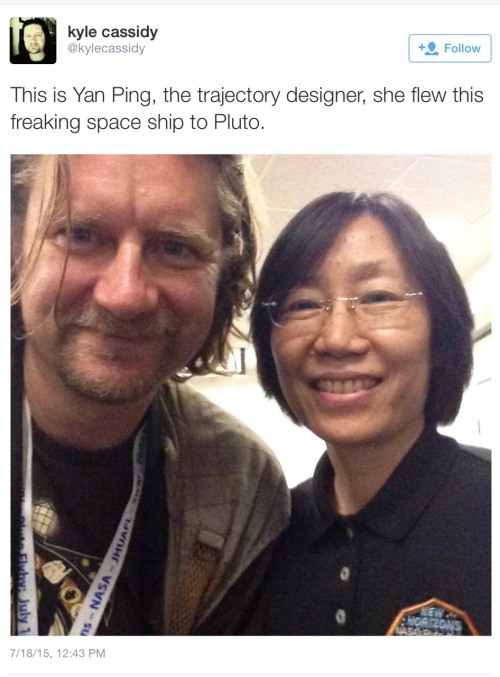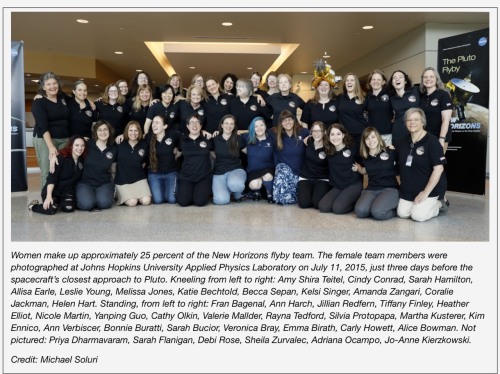Women Scientists Made Up 25% Of The Pluto Fly-by New Horizon Team. Make Sure You Share This, Because



Women scientists made up 25% of the Pluto fly-by New Horizon team. Make sure you share this, because erasing women’s achievements in science and history is a tradition. Happens every day. http://pluto.jhuapl.edu/News-Center/News-Article.php?page=20150712
More Posts from Prasannachoudhary and Others
A CRITIQUE OF THOMAS PIKETTY'S 'CAPITAL IN THE TWENTY-FIRST CENTURY' - 3
A CRITIQUE OF THOMAS PIKETTY’S ‘CAPITAL IN THE TWENTY-FIRST CENTURY’ – 3
CONTAINING CAPITAL – 3
Prasanna K Choudhary
Thomas Piketty zimbio.com
3. CAPITAL SOCIAL AND SELF-EXPANDING – 1
MONEY IS NOW PREGNANT. Goethe, ‘Faust’, Part I, Scene5.1
Let me begin with Thomas Piketty’s definition of capital, labor and ‘return on capital’. After all, ‘capital’ and ‘return on capital’ form the basic theme of the book.
Piketty writes, “In this book, capital is defined as the…
View On WordPress
Skysoaked: Jibanananda Das
Reblogged from translations:
Suranjana, you better not go there You better not talk to that young man Come back, Suranjana When silver starfire fills the night
Come back to this meadow, this wave Come back here to my heart Don’t go away with him anymore Fa…
View Post
Virtual Artists Talks Series: Praveen K. Chaudhry on New York City: Pand...

A quiet spring weekend was suddenly shattered on Sunday when news of the “Panama Papers” investigation broke.
“With the anointment of Yogi Adityanath as chief minister of Uttar Pradesh, Narendra Modi’s cunningly crafted ‘development’ mask has been ripped apart. .. There is much more to democracy than elections and legislative majorities. Even outside the realm of politics, battles need to be fought every day in every space to safeguard small freedoms, ensure peace, secure justice. Despair is an indulgence engaged citizens cannot afford - especially in light of the decision in UP.”

The Wayland Rudd Collection A project organized by Yevgeniy Fiks
The Wayland Rudd Collection focuses on the representation of Africans and African-Americans in Soviet visual culture. A point of departure for this project is Fiks’ collection of over 200 Soviet images (paintings, movie stills, posters, graphics, etc.) of Africans and African-Americans spanning from the 1920s to the 1980s. Fiks invited contemporary artists as well as activists, historians, sociologists, political theorists, and specialist in cultural studies to select one or more images from this collection and asked them to respond to it either via artwork, performance, lecture, or other forms.
Wayland Rudd was an American actor who began performing in the Hedgerow Theater in Rose Valley, Pennsylvania under the directorship of Jasper Deeter. Rudd first received critical acclaim for his performance in Eugene O’Neill’s “Emperor Jones.” Frustrated over racism in the entertainment industry, Rudd moved to the Soviet Union in 1932 where he began a successful career in Soviet Theater and Film including work with the famed Russian Director Vsevolod Meyerhold. He later received a degree from the Theatrical Art Institute in Moscow and worked at the Stanislavsky Opera and Drama Theater. Rudd died in Moscow in 1952.
During Wayland Rudd’s twenty year-long career in the Soviet Union, he appeared in numerous films, theatrical performances, and plays. He was also used as a model for paintings, drawings, and propaganda posters and, in many respects, defined the image of the “Negro” for generations of Soviet people. Although only a small section of the assembled images in The Wayland Rudd Collection are of Wayland Rudd, the project is given his name to commemorate this American-Soviet actor’s personal story as a case in point of the complex intersection of 20th century American-Soviet narrative.
The images in The Wayland Rudd Collection present a very complex and often contradictory mapping of the intersection of race and Communism in the Soviet context. The participatory aspect of this project adds the needed dimensions to show this complexity—giving the viewers the capacity to digest this history. This project investigates the promise and reality of Communism vis-à-vis the issue of race in the 20th century through the Soviet experiment. It presents this issue as unresolved, revealing the Soviet legacy on race as a mix bag of internationalism, solidarity, humanism, Communist ideals as well as exoticization, otherness, racist stereotyping, and hypocrisy.
Participants: Suzanne Broughel, Maria Buyondo, Dread Scott, Jenny Polak, Michael Paul Britto, Nikolay Oleynikov, Ivan Brazhkin, Haim Sokol, Kara Lynch, Dr. Allison Blakely, Dr. Romy Taylor, and others
Hips Liberated Because the Feet Have Been Shackled
Hips Liberated Because the Feet Have Been Shackled
Originally posted on COOLIE WOMAN:
Michael Goldberg Collection, U.W.I., Trinidad. http://www.cooliewoman.com
For the new Indian site Scroll.in, I wrote about my affection for chutney music. Here’s the piece:
Bollywood and my mother’s bhajans were the background music of my childhood. Growing up in New Jersey in the 1980s, any and all yearning for lost homelands was set to the score of…
View On WordPress

St. Mark’s Square II, Venice, 2007, Guy Sargent

-
 eccentricrage reblogged this · 2 weeks ago
eccentricrage reblogged this · 2 weeks ago -
 eccentricrage liked this · 2 weeks ago
eccentricrage liked this · 2 weeks ago -
 queenofcthulu liked this · 2 weeks ago
queenofcthulu liked this · 2 weeks ago -
 maaandrews17 reblogged this · 2 weeks ago
maaandrews17 reblogged this · 2 weeks ago -
 sleepdeprivedkat reblogged this · 2 weeks ago
sleepdeprivedkat reblogged this · 2 weeks ago -
 sleepdeprivedkat liked this · 2 weeks ago
sleepdeprivedkat liked this · 2 weeks ago -
 raphslovemuffin80 liked this · 2 weeks ago
raphslovemuffin80 liked this · 2 weeks ago -
 jenuinelycurious reblogged this · 2 weeks ago
jenuinelycurious reblogged this · 2 weeks ago -
 jenuinelycurious liked this · 2 weeks ago
jenuinelycurious liked this · 2 weeks ago -
 flaminglily liked this · 2 weeks ago
flaminglily liked this · 2 weeks ago -
 thelaundrybitch reblogged this · 2 weeks ago
thelaundrybitch reblogged this · 2 weeks ago -
 social-justice-raccoon reblogged this · 3 weeks ago
social-justice-raccoon reblogged this · 3 weeks ago -
 amchrisha liked this · 3 weeks ago
amchrisha liked this · 3 weeks ago -
 fandomcrazygirl13 reblogged this · 3 weeks ago
fandomcrazygirl13 reblogged this · 3 weeks ago -
 unfortunateskkhyperfixation reblogged this · 3 weeks ago
unfortunateskkhyperfixation reblogged this · 3 weeks ago -
 unfortunateskkhyperfixation liked this · 3 weeks ago
unfortunateskkhyperfixation liked this · 3 weeks ago -
 mori-makes-art liked this · 4 weeks ago
mori-makes-art liked this · 4 weeks ago -
 whattheduck94 reblogged this · 4 weeks ago
whattheduck94 reblogged this · 4 weeks ago -
 cramschoolcorp liked this · 4 weeks ago
cramschoolcorp liked this · 4 weeks ago -
 kurotaurus17 liked this · 4 weeks ago
kurotaurus17 liked this · 4 weeks ago -
 toylion liked this · 4 weeks ago
toylion liked this · 4 weeks ago -
 toylion reblogged this · 4 weeks ago
toylion reblogged this · 4 weeks ago -
 ajokeaboutadog liked this · 4 weeks ago
ajokeaboutadog liked this · 4 weeks ago -
 pink-vacancy reblogged this · 4 weeks ago
pink-vacancy reblogged this · 4 weeks ago -
 pink-vacancy liked this · 4 weeks ago
pink-vacancy liked this · 4 weeks ago -
 xia-thebimbo-of-titznwine reblogged this · 4 weeks ago
xia-thebimbo-of-titznwine reblogged this · 4 weeks ago -
 xia-thebimbo-of-titznwine liked this · 4 weeks ago
xia-thebimbo-of-titznwine liked this · 4 weeks ago -
 msaigon reblogged this · 4 weeks ago
msaigon reblogged this · 4 weeks ago -
 porschethemermaid reblogged this · 1 month ago
porschethemermaid reblogged this · 1 month ago -
 grayladyofthewell liked this · 1 month ago
grayladyofthewell liked this · 1 month ago -
 ofbloodandshadow reblogged this · 1 month ago
ofbloodandshadow reblogged this · 1 month ago -
 aseariel reblogged this · 1 month ago
aseariel reblogged this · 1 month ago -
 thismakesmybrainshutup reblogged this · 1 month ago
thismakesmybrainshutup reblogged this · 1 month ago -
 verityontheothersites reblogged this · 1 month ago
verityontheothersites reblogged this · 1 month ago -
 whatiwantyoutobe reblogged this · 1 month ago
whatiwantyoutobe reblogged this · 1 month ago -
 unus-annus-and-stuff reblogged this · 1 month ago
unus-annus-and-stuff reblogged this · 1 month ago -
 fettucine-afraido reblogged this · 1 month ago
fettucine-afraido reblogged this · 1 month ago -
 fettucine-afraido liked this · 1 month ago
fettucine-afraido liked this · 1 month ago -
 finallygaveintothesirencall reblogged this · 1 month ago
finallygaveintothesirencall reblogged this · 1 month ago -
 aka-catnip liked this · 1 month ago
aka-catnip liked this · 1 month ago -
 iceandbone reblogged this · 1 month ago
iceandbone reblogged this · 1 month ago -
 thismakesmybrainshutup liked this · 1 month ago
thismakesmybrainshutup liked this · 1 month ago -
 littlemissfandomworld reblogged this · 1 month ago
littlemissfandomworld reblogged this · 1 month ago -
 littlemissfandomworld liked this · 1 month ago
littlemissfandomworld liked this · 1 month ago -
 leshuga27 reblogged this · 1 month ago
leshuga27 reblogged this · 1 month ago -
 leshuga27 liked this · 1 month ago
leshuga27 liked this · 1 month ago -
 missfitz reblogged this · 1 month ago
missfitz reblogged this · 1 month ago -
 justjakescharacters liked this · 1 month ago
justjakescharacters liked this · 1 month ago

'Naitaavad enaa, paro anyad asti' (There is not merely this, but a transcendent other). Rgveda. X, 31.8.
210 posts